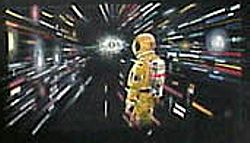Ring Around the Moon
The moon becomes a prisoner of an alien planet as an eerie new menace grips Alpha in a ring of light and turns Dr. Helena Russell into an involuntary informer, with death as her threatened reward. ITC summary
- This was adapted by di Lorenzo probably from one of the early story concepts.
- Original story outline "Fly Trap" by Donald Jonson (who wrote for Danger Man and The Protectors, and the 1973 science fiction play for ITV, A.D.A.M.) See To Everything That Might Have Been by Wood, Hirsch (2022) pages 137-148
- Script dated 14th December 1973; green page amendments 17th January 1974
- Final draft dated 8th February 1974. Filmed 27th February- 14th March 1974 (12 filming days, 4 days over schedule)
- Edited into the 1976 Italian compilation movie Spazio 1999
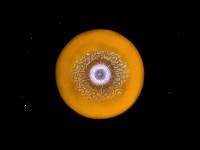
- There are some very fake looking SFX shots. The Triton eye is obviously a painting, with a flashing strobe as it speaks. The animated light beams hitting the Eagle and splitting are shot from a boring side angle. There are also some obvious shots of bubbling coloured chemicals before the explosions at the end. Highlights are the Eagle crash and nice shots of the Eagle in darkness.
- Library Special Effects
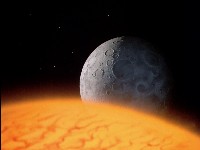
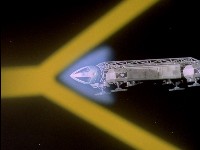
Original score by Vic Elms and Alan Willis, recorded at Wembley on Monday 6th May 1974. Vic Elms was supposed to have prepared a score and conduct the orchestra. But Elms could not write music and did not know how to conduct. Instead he tried to demonstrate themes on his guitar. The orchestra refused to work with him, so (music arranger) Alan Willis had to take over, improvising some scores on the day.
- the ominous drum sounds from the start of Drumdramatics No.1 by Robert Farnon is heard is the second half of the moonwalk sequence
- Library track from Thunderbirds "The Mighty Atom" by Barry Gray
- ITC Music Cue Sheet
History
- The Pyramid Texts of the Old Kingdom date from 3000 BC. These are the hieroglyphics inscribed on the walls of inner chambers of the pyramids at Saqqarah for several 5th and 6th dynasty kings (the earliest is that of Unas, last king of the 5th dynasty). They are mortuary prayers, hymns, and spells intended to protect a dead king or queen and ensure life and prosperity in the afterlife. They are the original texts of what later became known (when compiled into papyrus books) as the Book Of The Dead.
The "eyes of heaven" probably refers to the eyes of the falcon god, Horus. Horus loses his left eye to the god Set, but it was restored by Thoth (the moon). The "eye of Horus" symbol refers to sacrifice and healing, and is found on jewellery and the bow of boats.
- In the script, Bergman also refers to the "Shu King" (also known as the Shujing, Shangshu and, in English, the Book of Documents). These were traditionally credited to Confucius (551-479 BC), and consist of speeches by kings and ministers of the early period of the Zhou dynasty (around 1046 BC), and older reigns. Bergman refers to the aftermath of the Great Flood (Gun-Yu) from the Canon of Yao, the oldest in chronology (probably 2200 BC) but compiled more recently than the other chapters (around the 3rd century BC).
- The idea of "ancient astronauts" visiting early human civilizations such as Ancient Egypt is a ridiculous idea popularised by the discredited books of Erich von Daniken.
Astronomy
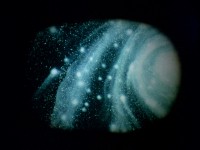
- How does Bergman know of the planet Triton? Somehow by name he can locate where a destroyed star is in his "galaxy charts" 2 million light years away. In the original story outline "Fly Trap", Bergman asks and is told the location. In the script, the implication seems to be that the Pyramid Texts describe a star that in historical times became a supernova. The most famous example is by Chinese astronomers, who recorded a star in Taurus which exploded in 1054, creating the Crab Nebula. In 1885, Ernst Hartwig discovered Supernova 1885, also later named S Andromedae, in the Andromeda galaxy, 2 million light years from Earth. It is the first supernova observed outside the Milky Way, and the only one so far in the Andromeda galaxy. The remnant of Supernova 1885 was discovered in 1985, more than 100 years later, by R A Fesen and others, and further observations were made by the Hubble Space Telescope in 1995.
- E C Tubb's novelisation suggests the planet Triton is the moon of Neptune with the same name. Triton is the only large moon with a retrograde orbit. The extreme cold, negligible atmosphere and ice volcanoes are inimical to life. But the fact that it must have been a rogue planetoid that was captured in Neptune's orbit has interesting parallels with the Moon in the series, and the inconsistency of space.
- There is a gross error in astronomical terms as Koenig describes the star pictures: "This is Triton's galaxy. This is Triton's star system. This is Triton's universe. This is Triton's sun." The universe contains all stars and galaxies- it is everything. Perhaps a completely unrelated slide slipped in and Koenig improvised... (The error is in both the 14 December and 8 February scripts)
Physics
- Koenig tells Paul: "Paul. Try to make contact with them. Use sound, light, radio wave patterns, the entire frequency scale." Sound cannot travel through the vacuum of space.
- Koenig and Carter faint after being subjected to at least one minute of high
g-forces (NASA experiments indicate an upper limit of about 10 g for seated pilots).
A common misconception in Space:1999 is the assumption that a spacecraft will stop
once the engine has been cut. Since there is no air drag in space, the Eagle will be
slowed down only by the Moon's gravity. If lunar escape velocity has been reached,
the Eagle would have to perform a propulsive braking manoeuvre to return to the
Moon. (Marcus Lindroos)
- This is one of the few episodes to include Eagle range and velocity figures. The units of
measurement are not specified, but the dialogue becomes logically plausible if the
velocity readings are in thousands of feet per second while the range is measured in
nautical miles. It seems Carter and Koenig initially accelerate from 7.5K ft./s to
8.3K ft./s in not less than 9 seconds, i.e. three earth gravities. The acceleration
from 8.3K to 9.1K seems more gradual (1-g or comparable to that of a fast car). (Marcus Lindroos)
- The range figures (from 100 nmi to 35 nmi in about a minute) indicate the Eagle is
initially moving at ~1.7 - ~2.2 kilometres per second i.e. the same velocity as real
life spacecraft accelerating out of a low lunar orbit. (Marcus Lindroos)
- Morrow specifies the Eagle crash site lunar surface by distance measured in metres. This is in
line with NASA's actual Apollo practices (imperial units for velocity and altitude/range, SI units on the lunar surface). (Marcus Lindroos)
Biology
- "The analysis shows that the cerebrum, which regulates speech, hearing, and most important in this case, vision, had expanded to three times its normal size." The cerebrum forms 85% of the brain mass, and is the grey matter than covers the white mass of the midbrain. The visual processing centre of the cerebrum is the occipital cortex, located at the rear of the skull. The ball of light is located in the cerebellum, at the bottom of the brain directly above the brainstem. This area controls movement, including learning motor tasks, from walking to riding a bike. Thanks to Meredith Girard
Helena also mentions "the neuronal system, which transmits information to the body through the nerves". This is generally called the neural system, although the term is used to describe processes for individual nerve cells (neurons).
- When Mathias checks out Helena after her return from the Triton probe, he states "Blood pressure's normal, eighty over a hundred and twenty." This is reversed: normally blood pressure is written as the systolic (peak) pressure over the diastolic (lowest) pressure. 120/80 mmHg is a standard adult value. Thanks to Meredith Girard
- Mathias raises a pen to Helena's eyes. "How many do you see?" "Two. I should see four." To check for double vision (diplopia) you move the eyes together right to left or up and down; even then you would see two images, not four. While it is rarely possible to see two images from only one eye, this is exceedingly uncommon and due to rare retinal problems. Moving an object in straight line toward the eyes checks for accommodation, or a person's focusing ability. Thanks to Meredith Girard
Early Main Mission layout
2 fatalities: Ted Clifford, Donovan
Alpha Technology:
Eagle 1 (Koenig); 3 (Alan & Donovan, crashed)
The Eagle crash is repeated in Space Brain.
None. We learn Triton is destroyed.
Aliens:
Tritonians. They do not have human form.
Props:
- The robe Helena wears in the Triton void is re-used in War Games.
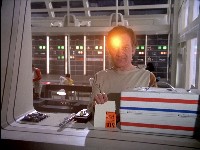
When Clifford puts his instrument down on the viewport sill, it is obvious there is no glass.
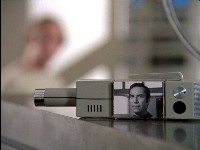
When Koenig puts his commlock down during the interview with Alan, it features his picture on the full side of the commlock. In other shots it is a normal smaller picture.
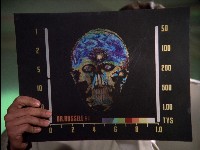
Helena's thermograph is held up the wrong way round (so we can read her name).
- The short story concept is padded out into a full episode by repeated Eagle trips and slow exposition. However, the story has a strong visual style with vivid colour and abstract light effects. A preproduction painting by Keith Wilson shows a strong 2001 influence.
- In the original script, the planet name was Uralt (German for "ancient"), not Triton. Chief Engineer Smith (Smitty, seen in Black Sun) is a minor character. The ethereal, abstract qualities of the episode are entirely absent in di Lorenzo's mechanistic science fiction story.
- "A good story, efficient performance and direction, with good up-beat pacing. The story however is badly plotted and this makes it somewhat confusing to follow in places" 3/5 Critical Commentary by Johnny Byrne (1975)
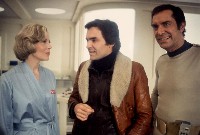
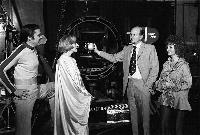
External Links
![]() Year 1 - Episode 4
Year 1 - Episode 4 ![]()



